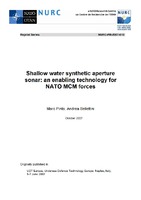| dc.contributor.author | Pinto, Marc A. | |
| dc.contributor.author | Bellettini, Andrea | |
| dc.date.accessioned | 2018-10-11T14:09:31Z | |
| dc.date.available | 2018-10-11T14:09:31Z | |
| dc.date.issued | 2007/10 | |
| dc.identifier | 25379 | |
| dc.identifier.govdoc | NURC-PR-2007-010 | |
| dc.identifier.uri | http://hdl.handle.net/20.500.12489/617 | |
| dc.description.abstract | The change in military focus from Cold War doctrine to expeditionary operations in shallower littoral water and the heightened terrorist threat to ports and their approaches, have put increased emphasis on countering smaller, stealthier sea mines and improvised weapons. The detection and classification of these new targets, which are often much smaller and of irregular shape, poses new challenges to existing mine | |
| dc.description.abstract | countermeasures (MCM) systems, which were not designed for this task. Firstly these targets are much more difficult to detect, because their target strength is an order of magnitude lower than that of the Cold War targets, which were | |
| dc.description.abstract | essentially spherical or cylindrical objects several meters long. A solution to this problem is now well known. Several NATO Nations, such as FRA, BEL, NLD and GBR, have invested in upgrades of their MCM systems, and benefit from recent advances in sonar technology (such as wideband sonar) which enable the effective detection of such targets, even at long ranges. But detection is only part of the problem and what is needed at the end of the day | |
| dc.description.abstract | in MCM is high confidence that all remaining objects in a given area are not mines. The problem posed by the modern threats is that there are many more natural objects of similar target strength on the seabed than before, which will now all be detected. Maintaining the efficiency of the overall MCM operation (e.g. | |
| dc.description.abstract | residual risk for given time on task) requires also a significant improvement in the classification probability. The effective classification of modern mines remains a challenge for existing systems. As for improvised explosive weapons, their classification seems a daunting task, unless intelligence on the threat can provide enough a priori information and/or techniques such as route survey can be used. | |
| dc.format | 8 p. : ill., digital (PDF file) | |
| dc.language | English | |
| dc.publisher | NURC | |
| dc.source | Originally published in: UDT Europe, Undersea Defence Technology Europe, Naples, Italy, 5-7 June 2007 | |
| dc.subject | Synthetic Aperture Sonar (SAS) | |
| dc.subject | Shallow water | |
| dc.subject | Mine countermeasures (MCM) | |
| dc.subject | Unmanned Underwater Vehicles (UUV) | |
| dc.title | Shallow water synthetic aperture sonar: an enabling technology for NATO MCM forces | |
| dc.type | Reprint (PR) | |
| dc.type | Papers and Articles | |
